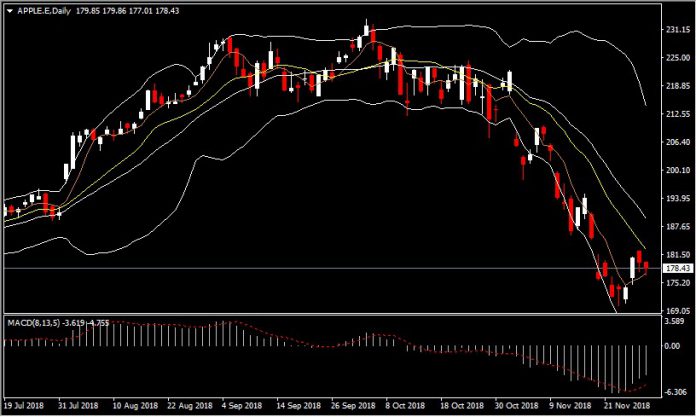Apple’s stock price officially entered a bear market last week. The stock’s performance has been weighing on a battery of bad news, mostly associated with low demand for new iPhone sales (which accounted for about 78% of total sales in 2018) and the impact additional tariffs on China would have on the phone’s price, which was estimated at $160 per unit. Add to that increased worries about data breaches, with software makers “guaranteeing” that they can break into any locked iPhone, then you are looking at a perfect storm.
To be fair to Apple, software glitches and security holes will always exist. The same holds for the China tariffs which are really beyond the company’s control. However, what seems to have put many customers off is the price of the new iPhones. Don’t get me wrong: it’s not that other companies are selling much cheaper phones but the price jump over the past two years has been astounding: The price jump from iPhone 7 to iPhone X, was about 18.5%, while the price increase from iPhone X to XS was an impressive 26.5%. Overall, prices for the top Apple phones have increased by approximately 50% over the last two years. This has helped Apple’s revenues from iPhones grow despite almost zero growth in the number of iPhones sold.
Tech fans are going to argue about the “innovative” features of the new iPhones, which could justify the price increases. However, it should be remembered that Apple does not operate in a vacuum, as competitors have been catching up really quick, with Huawei and Samsung introducing similar innovations, with their devices usually remaining on the cheaper side.
Of course, there is the luxury side of holding an iPhone: as recent research has shown, owning an Apple product was the best predictor that its holder would be in the top 30% income percentile in 2016 in the United States. However, notice that there is a huge difference between a luxury brand and a retail brand as the first focuses on high prices and low sales volumes and the latter on low prices and high sales volumes. In essence, we are talking about two different types of businesses.
Apple’s current business model, however, aims to make the best of both worlds and has, until last year, been succeeding. High volumes were also associated with high prices, leading to increased revenues for the firm. Still, with the majority of its sales stemming from the Americas, Europe and Japan where annual growth rates usually fluctuate around 2% annually, there is little chance of being able to continue such a strategy successfully, unless the drop in developed country sales is overcome by sales in China and other developing economies.
It appears that Apple has, either knowingly or unknowingly, been following this “status symbol” strategy for at least the past couple of years, perhaps acknowledging that the smartphone market, and especially that aimed at middle-income brackets, is showing signs of saturation all around the world. In essence, Apple aims at capturing the mid-level and high-end parts of the market, which is why it has been promoting two models each year, aimed precisely at those market segments. Such a strategy allows it to compensate lower unit sales with higher pricing while mid-level sales continue to provide a stable source of income.
After all, an iPhone is still a status symbol, even if it’s the cheaper of the two models. It’s all about keeping up with the Joneses.
As for the other 22% of Apple sales, it still remains to be seen whether the company will be able to push them through even as unit sales decrease.
Click here to access the HotForex Economic Calendar
Dr Nektarios Michail
Market Analyst
HotForex
Disclaimer: This material is provided as a general marketing communication for information purposes only and does not constitute an independent investment research. Nothing in this communication contains, or should be considered as containing, an investment advice or an investment recommendation or a solicitation for the purpose of buying or selling of any financial instrument. All information provided is gathered from reputable sources and any information containing an indication of past performance is not a guarantee or reliable indicator of future performance. Users acknowledge that any investment in FX and CFDs products is characterized by a certain degree of uncertainty and that any investment of this nature involves a high level of risk for which the users are solely responsible and liable. We assume no liability for any loss arising from any investment made based on the information provided in this communication. This communication must not be reproduced or further distributed without our prior written permission.



















